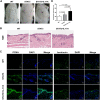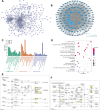IL-17A exacerbates psoriasis in a STAT3 overexpressing mouse model
- PMID: 37465147
- PMCID: PMC10351506
- DOI: 10.7717/peerj.15727
IL-17A exacerbates psoriasis in a STAT3 overexpressing mouse model
Abstract
Background: Psoriasis is an autoimmune skin disease characterized by immunocyte activation, excessive proliferation, and abnormal differentiation of keratinocytes. Signal transducers and activators of transcription 3 (STAT3) play a crucial role in linking activated keratinocytes and immunocytes during psoriasis development. T helper (Th) 17 cells and secreted interleukin (IL)-17A contribute to its pathogenesis. IL-17A treated STAT3 overexpressing mouse model might serve as an animal model for psoriasis.
Methods: In this study, we established a mouse model of psoriasiform dermatitis by intradermal IL-17A injection in STAT3 overexpressing mice. Transcriptome analyses were performed on the skin of wild type (WT), STAT3, and IL-17A treated STAT3 mice. Bioinformatics-based functional enrichment analysis was conducted to predict biological pathways. Meanwhile, the morphological and pathological features of skin lesions were observed, and the DEGs were verified by qPCR.
Results: IL-17A treated STAT3 mice skin lesions displayed the pathological features of hyperkeratosis and parakeratosis. The DEGs between IL-17A treated STAT3 mice and WT mice were highly consistent with those observed in psoriasis patients, including S100A8, S100A9, Sprr2, and LCE. Gene ontology (GO) analysis of the core DEGs revealed a robust immune response, chemotaxis, and cornified envelope, et al. The major KEGG enrichment pathways included IL-17 and Toll-like receptor signaling pathways.
Conclusion: IL-17A exacerbates psoriasis dermatitis in a STAT3 overexpressing mouse.
Keywords: Bioinformatics; IL-17A; Mouse model; Psoriasis; STAT3.
© 2023 Xie et al.
Conflict of interest statement
The authors declare that they have no competing interests.
Figures





Similar articles
-
Indirubin ameliorates imiquimod-induced psoriasis-like skin lesions in mice by inhibiting inflammatory responses mediated by IL-17A-producing γδ T cells.Mol Immunol. 2018 Sep;101:386-395. doi: 10.1016/j.molimm.2018.07.011. Epub 2018 Jul 29. Mol Immunol. 2018. PMID: 30064075
-
3, 3'- diindolylmethane hinders IL-17A/IL-17RA interaction and mitigates imiquimod-induced psoriasiform in mice.Int Immunopharmacol. 2022 Aug;109:108795. doi: 10.1016/j.intimp.2022.108795. Epub 2022 Apr 26. Int Immunopharmacol. 2022. PMID: 35487087
-
Glycyrrhizin improves the pathogenesis of psoriasis partially through IL-17A and the SIRT1-STAT3 axis.BMC Immunol. 2021 May 27;22(1):34. doi: 10.1186/s12865-021-00421-z. BMC Immunol. 2021. PMID: 34044769 Free PMC article.
-
IL-17 for therapy.J Dermatol Sci. 2017 Sep;87(3):221-227. doi: 10.1016/j.jdermsci.2017.06.010. Epub 2017 Jun 15. J Dermatol Sci. 2017. PMID: 28633806 Review.
-
Interleukin-17A and Keratinocytes in Psoriasis.Int J Mol Sci. 2020 Feb 13;21(4):1275. doi: 10.3390/ijms21041275. Int J Mol Sci. 2020. PMID: 32070069 Free PMC article. Review.
Cited by
-
Causal role of immune cells in psoriasis: a Mendelian randomization analysis.Front Immunol. 2024 Mar 15;15:1326717. doi: 10.3389/fimmu.2024.1326717. eCollection 2024. Front Immunol. 2024. PMID: 38558803 Free PMC article.
-
Pathophysiology and Treatment of Psoriasis: From Clinical Practice to Basic Research.Pharmaceutics. 2025 Jan 3;17(1):56. doi: 10.3390/pharmaceutics17010056. Pharmaceutics. 2025. PMID: 39861704 Free PMC article. Review.
References
-
- Bergboer JG, Tjabringa GS, Kamsteeg M, van Vlijmen-Willems IM, Rodijk-Olthuis D, Jansen PA, Thuret JY, Narita M, Ishida-Yamamoto A, Zeeuwen PL, Schalkwijk J. Psoriasis risk genes of the late cornified envelope-3 group are distinctly expressed compared with genes of other LCE groups. The American Journal of Pathology. 2011;178(4):1470–1477. doi: 10.1016/j.ajpath.2010.12.017. - DOI - PMC - PubMed
-
- Chiricozzi A, Guttman-Yassky E, Suarez-Farinas M, Nograles KE, Tian S, Cardinale I, Chimenti S, Krueger JG. Integrative responses to IL-17 and TNF-alpha in human keratinocytes account for key inflammatory pathogenic circuits in psoriasis. Journal of Investigative Dermatology. 2011;131(3):677–687. doi: 10.1038/jid.2010.340. - DOI - PubMed
Publication types
MeSH terms
Substances
LinkOut - more resources
Full Text Sources
Medical
Miscellaneous

